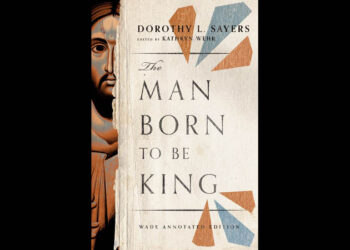Earlier this month, I encountered a whimsical bit of design in a delightful murder mystery. Just before the half-title page, there was a page displaying Ronald Knox’s Ten Commandments of Detective Fiction. In the upper right hand corner of that page appeared a dotted line and the words “Fold Here”. An active reader would laugh, having gotten the signal that this was a Golden Age mystery with the author committing to playing fair with the reader while the editorial team suggest a bookmark mechanism for checking he’d done so. Our thoughtful reader might well want to check Rule 6 when it is referenced on page 270 (two thirds of the way through the book). Dogeared pages help. (Of course, I can’t be sure if the joke appeared as part of the ebook. After all, would the inclusion have made sense in such a context? Or in the context of an audio file?)
Unless you’re regularly working with print, it’s easy to overlook the ways in which conventional page layouts or navigational practices shape a reading experience. Historically speaking, pages have numbers; follow the numbers – whether displayed in a table of contents or an index – and you’ll reach the desired point. Production design helps here. We make assumptions about the audience being served and the variety of ways in which they might expect to navigate content.
Perhaps an apology is due here. Navigation of long-form content isn’t nearly as hot a topic for readers of the Scholarly Kitchen as would be a post on artificial intelligence. AI probably won’t resolve navigational concerns in an ebook any more than one would expect it to discourage the damaging behavior of dog-earing the page. That said, let’s remind ourselves that innovative development in support of serious reading might be just as welcome in the day-to-day experience of our communities.
Oxford University Press (OUP) offers a paperback edition in their World’s Classics series of the Authorized King James Version (1611) of the four Christian Gospels (Matthew, Mark, Luke and John). Intended for use in a classroom setting, the usual instructional supplements are included – an introduction, a chronology, selected bibliography, glossaries of unfamiliar vocabulary, people, and places. Each of the four Gospels are broken into the usual chapters; those chapters are laid out in modern-day paragraphs with superscripts indicating specific verses within the chapter. The font seems to be on the smaller size (9.5 or 10-pt) as is the leading on the page; nothing to intimidate, but nothing luxurious either. One could readily find and buzz through the assigned reading without confusion. Page numbers, chapter breaks and running heads, numbered verses — familiar navigation for students faced with unfamiliar biblical allusions in art history courses or Western Civ 101.
Turn to a second option for reading the same content – one not intended for the classroom, but rather targeting the mainstream, at-home reader. A (different) not-for-profit publisher offers a hardcover edition. Intended to encourage an immersive reading experience, the trim size is comfortable in the hand, with text in a 12-pt font on a cream-colored background soothing to the eye. One might hesitate to dog-ear one of these pages as a bookmark whereas it might be less-guilt inducing to manipulate the more utilitarian stock selected for the OUP title. Here, there is no numbering of chapters or of specific verses. Nor are there traditional breaks between chapters. (Running heads offer a token form of narrative orientation, but thumbing to a previous bit would be the usual hit-or-miss exercise.) The design objective here is to facilitate a straight-line, read-through. The publisher encourages you to find a comfy chair, turn the pages, and see for yourself how the story unfolds.
In the context of navigation, neither of these treatments have done anything particularly extraordinary, certainly nothing to emphasize the nature of the content. In both instances, the variables of production were tailored to specific tasks in specific contexts, maximizing efficient use of the reader’s time.
Assumptions about the reader and navigational behaviors form the basis of how a book will be laid out. By including that “Fold Here” instruction in the murder mystery, the designer acknowledges a common behavior (dog–earing a page), something usually invisible to anyone but the reader. Rather than discouraging damage to the physical product, the publishing team (author, editor, designer) were signaling to the reader that in this instance the action would be understandable and, in fact, perceived as a lesser crime.
Print layout is somewhat customizable, a good thing when a different form of reading demands a different approach. Some years back, the Ave Maria Press adopted a less-mainstream approach in delivering The Gospels for Prayer. Editor Michael Hansen, S.J., included an introduction, explaining the rationale for the format adopted. His focus was on developing a presentation of the four gospels that would serve practitioners of lectio divina. Individual pages were offered a single coherent story, event, or teaching, expecting that the reader sought a more reflective focus, being attentive to an isolated unit of text. In some instances, this assumption translated to just a single verse on the page – two or three lines of type. To the reader, what is most striking about the page layout is the amount of white space. The brevity of what’s visible on the page lends itself to a slower, less distracted style of reading. Allowing for that intended use, the text (without any supplementary materials) is spread across 600-650 pages – far more than either of the more mainstream titles previously mentioned.
Cost-effective design and production of a physical book requires a practical balance of factors. In this particular instance, selections of stock and binding needed to ensure that a reader’s engagement with the print faced no barriers to use (invisible or otherwise). The bound cover should be durable as well as flexible with an expectation that the open book would lie flat; sewn signatures should tolerate daily use. To minimize bulk, a thin, tear-resistant paper would be selected – scritta or similar india paper. Containing a final 738-page count, the total thickness of the text block is only five-eighths of an inch.
Orientation and navigation become more interesting, given the specific hope for minimal distraction. Standard page numbering appears in the upper outer corners of each page. At the foot, again at the outer edge, the reader is provided with a scripture reference for that text unit – book:chapter:verse. On the inner margin below the line, is the formatted reference of book:chapter:verse for the same story as it appears elsewhere in the Gospels. (As an example, on the page containing Matthew 22:34-50, the cross-reference directs the reader to Mark 12:28-34.) Below is a thin black line, indicating a purposeful division. On the outer edge below that, there is a succinct descriptive title of the content appearing on the previous page.
Most particularly in the print environment, readers recognize and understand the general conventions of navigation and orientation. Ideally, such mechanisms are unobtrusive to the point of invisibility until the reader encounters a need. My three examples reflect customizations to accommodate specific tasks and settings. Most likely, unless set side-by-side in a three-dimensional environment, the conventions wouldn’t even be noticed.
However, it is telling that of these three examples, only one of them is available from the provider in an alternate ebook form. Even in that instance, there is a surprising degree of incompatibility with reading apps and devices. Neither of the two print-only titles are currently available, except in the second-hand market. (To be fair, that may well be due to the nature of the content. However, all three examples carried 21st century copyright dates.)
In an ebook, the ordinary reader doesn’t have that many options for rapid orientation, particularly viewed on the limited screen of a mobile device. Running chapter heads are eliminated in favor of a continuous display of a main title. Assumptions about scrolling behavior negates the value of page numbers. Readers encounter difficulty in identifying which chapter they’re in unless they click back to the table of contents. On a hosted platform, an ebook’s template forces uniformity.
Readers adapt. To borrow from just one recent study of current behavior and expectations,
Findings showed that as students moved between locations, they also transited across devices, platforms, and formats, making use of different print and digital resources for varied ways of reading. Their ability to ‘style-shift’ flexibly across the boundaries of school and personal spaces, various devices and platforms allowed them to independently optimise reading as a resource for their everyday leisure, information seeking, and learning purposes.
Jason Murkowski, a key player in the technical development of Amazon’s Kindle, admitted in his 2013 book, Burning the Page: The Ebook Revolution and the Future of Reading, that ebooks reflected more the thinking of software developers than the thinking of publishers. He notes “all the e-readers are made in Silicon Valley. Apple, Amazon, and Barnes & Noble all have designers in Silicon Valley because that’s where the technical talent is. But what you don’t get with this technical talent is an artistic, book-oriented design”, (page 52). Twenty or thirty pages later, he points out another navigational aid where the digital approach requires improvement, “Indexes are a part of the book where ebooks suffer the most. Textbooks and most nonfiction books often have a section at the end where someone intimate with the text has scoured the book for its main subjects and created an index with the page numbers of when those subjects are mentioned. The best indexes are done by hand and are sometimes as lovingly long as a chapter in the book itself.”
Book publishers currently cope with other larger challenges (legacy systems, supply chain constraints, etc.). But as a reader daily using digital as well as print formats, I have to say that I haven’t seen much innovation since Murkowski wrote those words. Surely we’re not finished?
When it comes to ebooks, our scholarly sector increasingly expects to rely on ebooks and shared print collections as solutions for cost-containment and storage. If not intimidated by the speed of change and if such shifts do not impede the reading task at hand, serious readers will manage to make do.
The publisher’s value-add comes from providing an effective presentation of content and robust support for a variety of reading tasks. If there are gaps that impede the speed with which a reader’s task gets done, the utility of the book (whatever the format) is lessened and value in the eyes of the reader diminished. Reading for entertainment generally means you’re navigating a book just once. Reading for other purposes probably deserves more thoughtful and innovative support.
Discussion
8 Thoughts on "Navigating the Page and The Reader’s Task"
Working in a library which now takes a lot of material as ebooks, I regularly encounter scholars who find ebooks extremely challenging to reference and navigate. Until the academic community develops a simple approach to referencing ebooks, and publishers add the necessary functionality, there will still be resistance to using ebooks for scholarly purposes.
I agree, but clearly this isn’t anyone’s current priority. Speaking as a serious reader (as opposed to a scholarly researcher), if I need to read a serious text of criticism or historical non-fiction, the print is far more useful to me. Most of the academics with whom I engage on a regular basis (not a scientific sample) feel the same way.
Consider a traditional Talmud where there is the text and commentary, and commentary on the commentary, printed on the page. It’s a smart and beautifully designed set of books (although you can argue the logical placement of things). And althought there is a wealth of texts and scholarly commentary available online now (see Sefaria.org among others), I have great memories of learning the texts with a rabbi who wasn’t as fond of the digital versions because he claimed if he wanted a source, he could picture it on the page and knew exactly where to go to find that text. It was in a specific place on a specific page that he was familiar with. (He did not disparage digital texts, however.) “Search” or “find” in a digital document cannot replicate that ability to know what book to go to, what page to open to, and where that text was physically located. (And note that Orthodox Jews cannot even use a digital book on Shabbat–they need a physical book.)
The use case for the particular book publication is a critical consideration. It was something that was readily acknowledged in an all-print environment but I think the reliance on ebook templates could prove to be a hindrance if the information community is hoping that digital will begin to dominate.
In my observances, younger generations are not interested in being able to know which page something is on or being familiar with physical books in the least. Instead they are focused on immediate gratification which means doing an online search and taking the very first result as the answer.
Please, please, please continue writing posts in this vein, Jill. I’m in the middle of reading Faint Praise, which you highlighted in a previous post (https://scholarlykitchen.sspnet.org/2023/11/17/the-necessity-of-book-reviews/), and am downloading a sample of Burning the Page now, which you mentioned in this post. Keep going!
Thanks for the encouraging words!!
The general question of how to reference a section of a digital publication is very interesting and tricky (for books or journals). How do you cite a section when the page length is not fixed..? To be honest, “page” is not ideal either — I have frequently had to scan a page many times to find the right spot, particularly if it is not a direct quotation.
We could use a universal standard presumably based on the percentage of the distance through the work, but this would need to be acknowledged by most screen reader platforms to really work properly. I would love to read more on this topic, or hear anyone’s thoughts on this, or see references to more on this topic.




